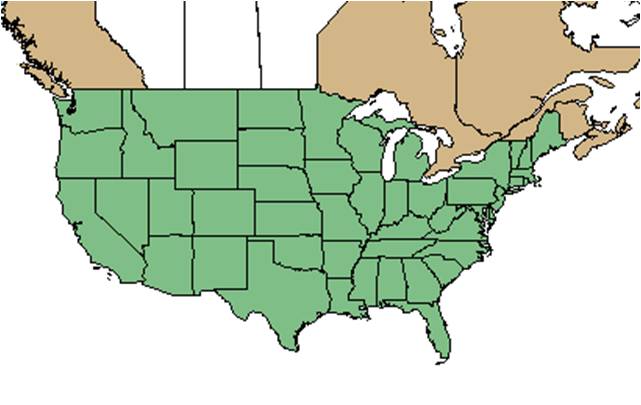Difference between revisions of "Lepidium virginicum"
KatieMccoy (talk | contribs) |
KatieMccoy (talk | contribs) |
||
| Line 38: | Line 38: | ||
===Phenology=== <!--Timing off flowering, fruiting, seed dispersal, and environmental triggers. Cite PanFlora website if appropriate: http://www.gilnelson.com/PanFlora/ --> | ===Phenology=== <!--Timing off flowering, fruiting, seed dispersal, and environmental triggers. Cite PanFlora website if appropriate: http://www.gilnelson.com/PanFlora/ --> | ||
| − | + | Initially ''L. virginicum'' appears as a low growing rosette with pinnatifid leaves, with a stem emerging later, branching occasionally, causing the plant to be bushy <ref name="illinois"/>. The tiny white flowers have 4 petals and 2 stamens and are found at the top of the raceme, with seeds appearing on the lower end of the raceme, replacing the flowers. It can be observed flowering and fruiting February through November (FSU Herbarium). | |
===Seed dispersal=== | ===Seed dispersal=== | ||
Revision as of 20:18, 12 January 2016
| Lepidium virginicum | |
|---|---|
Error creating thumbnail: Unable to save thumbnail to destination
| |
| Scientific classification | |
| Kingdom: | Plantae |
| Division: | Magnoliophyta - Flowering plants |
| Class: | Magnoliopsida – Dicotyledons |
| Order: | Capparales |
| Family: | Brassicaceae ⁄ Cruciferae |
| Genus: | virginicum |
| Species: | L. virginicum |
| Binomial name | |
| Lepidium virginicum L. | |

| |
| Natural range of Lepidium virginicum from USDA NRCS Plants Database. | |
Common name: Virginia pepperweed
Contents
Taxonomic notes
It is similiar to Lepidium campestre in both appearance and growth habitat; however,the lobed rosette leaves and the bottle brush appearance of mature L. virginicum can help distinguish the two species [1].
Description
A description of Lepidium virginicum is provided in The Flora of North America.
L. virginicum is a prolific weed that can either be an annual or biennial species, depending on environmental conditions [2]. Initially, it appears as a low growing rosette with pinnatifid leaves, later, the stems emerge upward, occasionally branching, often becoming bushy. Flowers can be found blooming at the top of the raceme, at the bottom, flattened seedpods take the place of flowers, often said to resemble a bottle-brush[3][1]. The flowers are small and white, with 4 petals and 2 stamens[2].
Distribution
This species can be found throughout North America, except Prairie Provinces and parts of the far north [2].
Ecology
Habitat
L. virginicum is usually found in disturbed areas such as roadsides, vacant lots, sandy fallow fields, and lawns. It has also be found in natural communities such as river floodplains, marshy salt flats bordering mangrove swamps, and sandy flats and shores of shallow lakes (FSU Herbarium). This species has been found growing in highly disturbed areas such as the Copper Basin, which has long been subjected to sulfur dioxide pollution and it has been observed to have a ecotypic adaptation resulting from natural selection in this area (Murdy 1979).
Soils include loamy sand and sandy loam. Associated species include cyperus and mangroves (FSU Herbarium).
Phenology
Initially L. virginicum appears as a low growing rosette with pinnatifid leaves, with a stem emerging later, branching occasionally, causing the plant to be bushy [3]. The tiny white flowers have 4 petals and 2 stamens and are found at the top of the raceme, with seeds appearing on the lower end of the raceme, replacing the flowers. It can be observed flowering and fruiting February through November (FSU Herbarium).
Seed dispersal
Seed bank and germination
Fire ecology
Pollination
The following Hymenoptera families and species were observed visiting flowers of Lepidium virginicum at Archbold Biological Station (Deyrup 2015):
Colletidae: Colletes mandibularis
Halictidae: Augochlorella gratiosa
Megachilidae: Heriades leavitti
Sphecidae: Ectemnius rufipes ais, Oxybelus laetus fulvipes, Tachysphex similis
Vespidae: Stenodynerus fundatiformis
Use by animals
Diseases and parasites
Conservation and Management
Cultivation and restoration
Photo Gallery
References and notes
Deyrup, M.A. and N.D. 2015. Database of observations of Hymenoptera visitations to flowers of plants on Archbold Biological Station, Florida, USA.
Florida State University Robert K. Godfrey Herbarium database. URL: http://herbarium.bio.fsu.edu. Last accessed: October 2015. Collectors: Loran C. Anderson, D.J. Banks, D.E. Breedlove, D. Burch, Andre F. Clewell, K. Craddock Burks, Suellen Folensbee, R.K. Godfrey, Gary R. Knight, Robert M. Laughlin, O. Lakela, Robert J. Lemaire, S.W. Leonard, Marc Minno, Richard Mitchell, Jackie Patman, Elmer C. Prichard, Gwynn W. Ramsey, Peter H. Raven, Cecil R. Slaughter, Victoria I. Sullivan, L.B. Trott, Edwin L. Tyson, Bruce Walton, D.B. Ward, Jean Wooten. States and Counties: Florida: Bay, Brevard, Collier, Dixie, Escambia, Franklin, Gadsden, Hamilton, Hernando, Hillsborough, Holmes, Indian River, Jackson, Jefferson, Leon, Liberty, Marion, Okaloosa, Orange, Polk, St. Johns, Taylor, Union, Volusia, Wakulla, Walton. Countries: Mexico, Panama. Compiled by Tall Timbers Research Station and Land Conservancy.